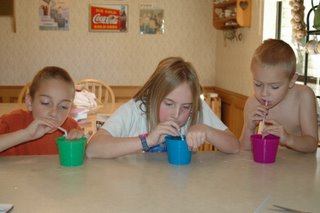We’ve begun a new book “Exploring Creation Through Zoology – Flying Creatures. There are now three texts in the Elementary Apologia Science. We finished the one on Astronomy. There is currently one on Botany and one on Zoology – Flying Creatures (with a second one in the works). ”. This is the last book that Jared will be doing “with” us as he will be moving into the Jr High science next year. We let him choose and this is the one he wanted to do. I’m not sure the younger ones can keep up with his pace but the plan is to teach them the highlights and do the experiments together….we’ll cycle through these elementary books again. This time, for instance, they dictate their findings to me and I am making one zoology notebook for the younger ones – they’ll be 6th and 5th when we hit this book again and that time they’d master the material and make personal notebooks.
Today we did the experiments that we never got around to fi
 nishing last week.
nishing last week.Here are the kids learning about lift and air pressure…..FUN. Jared had done this earlier and reported that it “does nothing”. We discussed the need to repeat your experiment many times to make sure your results are consistent. The younger ones had NOT done it and I warned him not to tell them what was “supposed” to happen. We filled out the Scientific Speculation sheet and prepared for the fun. The procedure is to blow air directly over the top of the straw in the cup. The glass is full of water. The little ones expected the straw to float up. As the air goes over the top of the one straw it creates the scenario where the pressure from below LIFTS the water – through the straw and across the counter. Zander was happy to “make bubbles” and not worry about lift and pressure at all.

After this experiment we did one on glider design. Our goal was to change only one variable in the experiment – the shape of the wings. We made great gliders from cereal boxes, straw, tape and play dough. We guessed which would fly the farthest and then we went outside to throw and measure…..a total of 20 x.
We ended up proving a couple of things:
1. The glider with the sleeker, longer wings averaged 3 ft further in flight than the glider with the wider, shorter wings.
2. The most well meaning scientists can sometimes alter variables in favor of their hypothesis and this must be carefully guarded against influencing the outcome. {grin}

